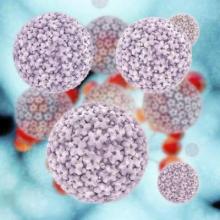High-risk human papillomavirus testing is acceptable as a primary approach to cervical cancer screening in women aged 25 years and older, according to interim clinical guidance from an expert panel convened by the Society of Gynecologic Oncology and the American Society for Colposcopy and Cervical Pathology.
Based on several large studies published since 2011 when screening guidelines were last updated, the panel concluded that a negative high-risk HPV (hrHPV) test provides greater reassurance of low cervical intraepithelial neoplasia grade 3–positive (CIN3+) risk than does a negative cytology result, and that “because of equivalent or superior effectiveness, primary hrHPV screening can be considered as an alternative to current U.S. cytology-based cervical cancer screening methods.”
The guidance was simultaneously published on Jan. 8 in Gynecologic Oncology (2015 [doi:10.1016/j.ygyno.2014.12.022]), the Journal of Lower Genital Tract Disease, and Obstetrics & Gynecology (2015;125:330-7 [doi:10.1097/AOG.0000000000000669]).
The 13-member panel was convened when an application was submitted to the U.S. Food and Drug Administration for a currently marketed HPV test to be labeled for the indication of primary cervical cancer screening; that application was approved in April 2013.
The panel included representatives from the American Society for Colposcopy and Cervical Pathology, the American College of Obstetricians and Gynecologists, the American Cancer Society, the American Society of Cytopathology, the College of American Pathologists, and the American Society for Clinical Pathology.
Cytology alone and cotesting remain the screening options specifically recommended in existing major guidelines. The interim guidance does not supplant those guidelines, but provides clinicians with an additional screening tool, Dr. Warner K. Huh of the University of Alabama at Birmingham, and his colleagues reported.


